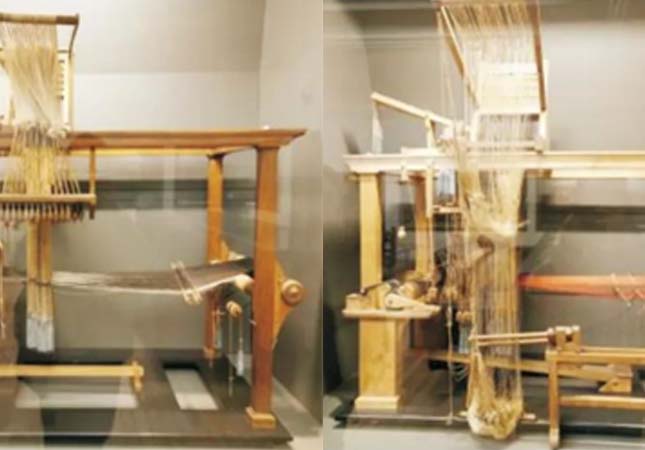French silk pattern designs underwent many changes around the 18th century and became the main source of patterns used in European silk weaving centers, especially in the jacquard machine industry, which was the core of the development of modern silk jacquard technology and played an important role in the historical development of Chinese silk weaving technology. Similar to the Chinese patterns of the Ming and Qing dynasties of the same period, the French silk patterns of the early 18th century expressed the patterns through blocky, flat patterns.
Development of French Jacquard Machine
Throughout the technical improvement of French jacquard machine, the initial prototype of jacquard machine, the basic weaving principle and the warp thread lifting control principle are all from the Chinese drawloom, which needs the cooperation of a warp lifter sit topside and a weaver downside to weave the fabric at the same time. However, there is fewer people are willing to engage in this work because of the hard and boring working process. The process of wrap lifting also is more likely to remain the weaving mistakes on the fabric surface, which effects the final look of a silk products.
The French jacquard machine technology improvement has been committed to find a system that can replace the work of the wrap lifter. The main improvements in the 17th-19th centuries were concentrated in the lifting control part of warp, that is, the controlled guide part of a modern jacquard machine. The revolution of the wire harness jacquard were mainly started in the 15th century when the linear pattern book was used,until 1725 when the pattern board was used. This was a major improvement in the warp control system, and the biggest revolution in the jacquard loom was the use of the pattern plate with no need of the wrap lifter.
1. Equipment Improvements for Linear Flowers Book
In the 15th century, France imported the wire heald jacquard loom from Italy , the prototype of which came from China and was improved in Persia, remains the linear pattern of the Chinese drawloom. It can be divided into 2 main categories according to the different tugging devices:"Skittle" loom and "Smiple" loom, both of which have the control of the flower book on the side of the machine. The "Skittle" loom has a small hammer at the end of the flower book, and the puller pulls down to lift the corresponding warp thread, while the "Smiple" loom has the end of the flower book fixed to the floor on the side of the loom, and the wrap lifter pulls to the side of the loom to lift the warp thread.

In the early 17th century, Claude Dangon improved the "Smiple" loom by changing the position of the flower puller from vertical to horizontal, similar to the position of the flower book of the Chinese drawloom, which broke the limitation of the number of flower book threads to be pulled in the vertical direction so that the number of loops of the flower book is greatly increased and larger fabrics can be woven. This type of loom was called a wide thread heald loom and was still in use until the mid-19th century. In the fabrics seen in the 17th-18th centuries, there were few fabrics with large flower patterned, such as typical Baroque fabrics with a flower pattern of about 1 m, which were used for wall decoration, for example, red Baroque fabrics with a flower pattern of 1.5 m.
2. Invention and Improvement of Jacque Loom
The invention and improvement of the pattern plate equipment has improved the accuracy of the weaving while reducing the difficulty of the wrap lifter's operation, which is already a great progress compared to the linear flower book. However, the loom still needed two workers to operate and fundamentally still did not completely replace the wrap lifter. Until 1748, when Jacques De Vaucanson developed the first fully automatic jacquard loom, which required only one weaver to operate the machine, finally freed the wrap lifter from hard working. Although protests by laid-off workers followed, the workers' strike could not stop the pace of technological progress.
The modern jacquard machine, also known as the jacar loom, is named after Joseph Marie Jacquard, in honor of this craftsman's contribution to the jacquard loom improvement. First of all, Jacquard was not the inventor of the jacquard loom, but rather a master craftsman who integrated the techniques of his predecessors. He borrowed the each advantage of the Bouchon, Falcon, and Dvorkansen looms to create the Jacar loom. However, the Jacar loom at that time had many drawbacks such as noisy mechanical system and laborious operation so that it was not popular. Jean Antoine Breton was the one who really made the jacquard loom practical for widely using. From 1815 to 1817, Breton simplified and optimized the mechanical part of the jacquard loom for automatic jacquard, which reduced the cost and made the loom work with less vibration and resistance, thus making the operation smoother and easier, It marked the birth of the true Jacquard loom.
In the 19th century, the jacquard loom was introduced to Germany, where German craftsmen experimented with using iron instead of wood to produce the loom parts, thus slowly evolving into the iron loom, which was later passed back to France and other places.




